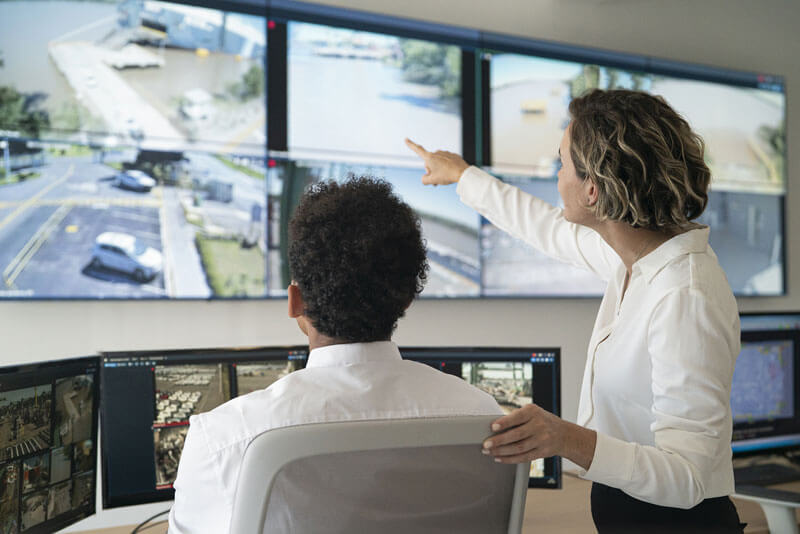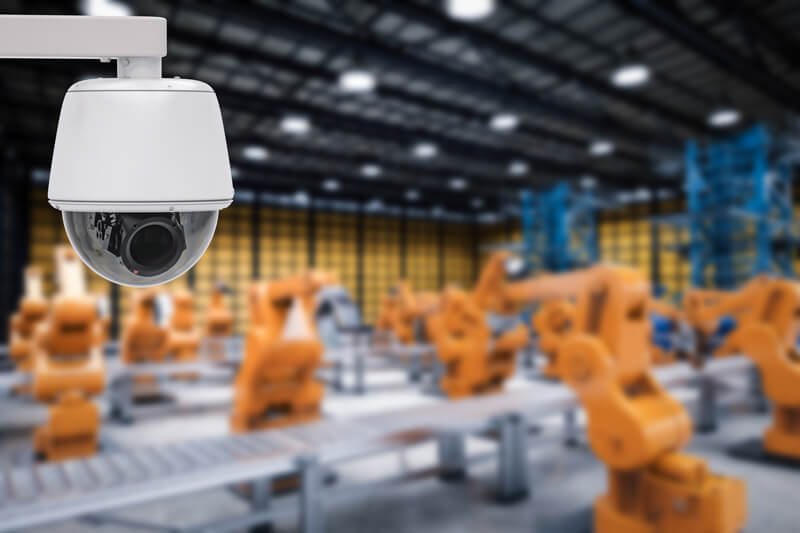Factories can appear chaotic to someone who hasn’t spent much time in one. However, everything is well choreographed, and what looks like chaos from the outside is actually a well-designed flow that turns materials into finished products. Manufacturing live video security can give you the help you need to make sure everything continues to go according to plan.
See how Solink improves the security level of your business with live video security.
Live video security is a way to monitor your manufacturing plants remotely in real time. Remote monitoring uses a combination of security cameras and advanced video analytics to keep an eye on your business. There are many benefits to using this technology, including enhanced security, lower costs, improved efficiency, and a better understanding of your core metrics.

Indeed, while most manufacturing businesses seek out live video security to improve security and safety, the benefits go far beyond reducing the risk of theft or employee injuries.
15 live video security benefits for manufacturing plants
As mentioned above, being able to monitor your business in real time has both security and non-security benefits. Here are 15 benefits of live video security:
- Identify retraining needs
- Respond to issues in real time
- Virtual guarding
- Remote monitoring
- Better asset protection/loss prevention
- Reduced labor expenses and hiring needs
- Better security with faster emergency response
- Alarm verification
- Reduced inventory shrinkage
- Enhanced safety
- Optimized operations
- Document events
- Upgrade your access control system
- Lower insurance premiums
- Keep shipping and receiving on time
- Better customer service
Note that these benefits often open up great synergies. For example, identifying retaining needs and documenting events will enhance safety in your factory.
Identify retraining needs
Employees often find themselves in need of retraining. This can be due to their lack of experience or mistakes made during initial training. Whether malicious or because of training shortcomings, the results are the same for the business: reduced profitability from lost productivity.
The following are two of the common retraining needs that often appear in manufacturing centers:
- Time theft: Time theft is when employees are being paid to work but are doing something else instead. This can be simple productivity issues such as employees using their mobile phones during work hours. However, it can also be more serious, for example coworkers manipulating the punch clock to bill overtime hours when they are already at home (sometimes called “buddy punching”). In a large manufacturing plant, some employees believe that they can get away with stealing time from their company because there are too many employees and too large a square footage to keep track of everyone’s productivity.
- Safety lapses due to short cuts: Employees might feel pressure to increase their productivity by cutting corners. To someone unfamiliar with the reasons behind certain standard operating procedures (SOPs), they can feel like the “slow way” of doing something. However, the SOPs are there for a reason, and employees skipping steps could lead to liability risks. It could also cause quality problems.
Volunteers of America-Michigan has identified several retraining issues using the Solink platform. Live video security has helped them find instances of employees not doing what they are supposed to without ever needing to step foot in the affected stores.
Respond to issues in real time
Issues tend to compound until they are solved. This means a small problem in the morning can spiral out of control leading to your business not meeting its goal. Factories are busy places, and having one truck unloaded late under a just in time inventory system could mean a work stoppage.
Threshold Notifications allows businesses to set limits on the metrics important to them: number of finished products produced per hour, value of merchandise produced per day, and anything else you can track. Then you can get a proactive notification any time your core metrics are outside of your comfort zone.
Virtual guarding
Virtual guarding is the use of live video security equipment to replace on-site security guards or enhance their ability to patrol large spaces. In either case, using your security system to replace live guards can save a lot of money.
In addition, security cameras never sleep, cannot be intimidated, provide objective evidence when an incident occurs, and can monitor your entire manufacturing plant at once. All of these added benefits are why many factory managers are using remote guards to protect their facilities.
Virtual guarding is particularly effective for manufacturing live video security. The design of large factories means there are a lot of different places where employee theft could take place. Using virtual guards instead means a single person can monitor the entire property simultaneously.

Remote monitoring
Remote video monitoring gives you the ability to audit your factory for company policy compliance from anywhere. While in-person inspections are not going away—and they shouldn’t—live video security can make it possible to follow-up on known safety or security violations more often.
Better asset protection/loss prevention
When discussing asset protection/loss prevention (AP/LP) for a manufacturing plant, it’s important to separate the different threats. Factories are more likely to experience Internal theft, which is when people inside an organization steal from it.
Factories experience two main types of internal theft. In the first case, employees use their knowledge and access to your manufacturing plant to steal materials, finished products, tools, and other supplies. In the second case, delivery drivers and/or vendors produce fraudulent shipping manifests to underdeliver needed materials.
Your manufacturing live video security system can reduce the risk of internal theft by creating a strong deterrence to criminal activity. In addition, when theft does occur, it is possible to review footage to discover what happened, when, and who was involved. That way incidents are resolved quickly and acceptably.
goPuff uses Solink to prevent employee theft in their distribution centers. Here’s what Scott Sanford, goPuff’s Director of Loss Prevention, has to say:
“In our environment, shoplifting isn’t a factor like it is for other companies, but we still have to be diligent about keeping our employees safe, managing our inventory and keeping honest people honest,”
Reduced labor expenses and hiring needs
Live video security can reduce labor expenses in several ways. Most directly, the virtual guarding function can replace live 24/7 on-site security guards. However, even when a full-time salary isn’t being removed from the books, video security systems can be used to improve productivity.
Here’s an example.
An employee makes an error when entering a shipment into your inventory management system (IMS). Then, when placed in storage for later use, it is lost. Finding the missing materials previously would have taken hours, if they could be found at all.
Now, manufacturing live video security can be used to find the order in minutes. Solink can help you look up the missing order to see it entering your factory. Then, with Camera Linking, you can follow the forklift as it moves through the building until the location of the missing materials is located.
Better security with faster emergency response
Solink is a complete video management system (VMS). With all of the included tools, you can now search for theft or other security incidents, save the videos, organize all the evidence gathered for an event, and share it internally and with law enforcement in one platform.
Solink Video Alarms Monitoring Service is another way to better protect your business with live video security. Unlike traditional panel alarms, video alarms can monitor entire areas of your manufacturing plant for improved detection. You can also turn them on and off one zone at a time, meaning your factory can keep working while the shipping area is secured.
Solink Video Alarms also gives companies the ability to share live footage of what is happening in their buildings with emergency dispatchers. Whether it’s an industrial accident, active shooter, or break and enter, emergency responders know exactly what is happening and can react more appropriately.
In a recent independent comparison of Solink Video Alarms and traditional panel alarms, video alarms led to multiple arrests while traditional alarms led to zero apprehensions.
Alarm verification
Alarm verification gives trained professionals the ability to review in real time what is happening on a site before deciding whether an emergency response is warranted. Then, when law enforcement is required, the video feed is shared with the dispatcher to ensure prompt and appropriate response.
However, the value of alarm verification goes beyond better security. Verified alarms also save you money. Many police forces no longer respond to unverified alarms, and where they do false alarm fines are increasing.
In the same head-to-head comparison mentioned above, Solink Video Alarms led to a 100% decrease in false alarm fines across multiple restaurant locations.
Reduced inventory shrinkage
Factories carry a lot of inventory, from needed materials to finished products, and therefore reducing inventory shrinkage is particularly important. The scale of potential loss makes the cost of a video monitoring system for a manufacturing plant trivial. Finding a single inventory theft incident could pay for a lifetime of live video security in your manufacturing plant.
goPuff uses Solink to reduce shrink in their distribution centers. Here’s what Scott Sanford, goPuff’s Director of Loss Prevention, has to say:
“Solink was able to upgrade existing systems with improved performance and speed, connectivity and intelligent features. Sixty systems were upgraded in just 30 days and now play an integral role in shrink reduction at existing sites. ROI is quickly achieved once implemented.”
Enhanced safety
Manufacturing facilities often have natural hazards for workers. If health and safety is not the top priority of everyone in the building, they can quickly become dangerous places to work. Live video security is deployed in factories primarily to make sure everyone is safe.
A well-connected and monitored manufacturing live video security system will improve the safety of your business. By monitoring company and regulatory compliance, you can make sure emergency exits are clear, forklift drivers are obeying the internal traffic signage, and dangerous equipment and chemicals are used correctly and always safely stored when not being used.
Workplace accidents are a common occurrence in manufacturing plants, especially when health and safety policies are not being followed. Some employees when feeling pressure to maintain a high level of productivity will cut corners, leading to an unsafe work environment.
Manufacturing live video security can help ensure that all safety policies are being followed. These same policies, for example forklift speed limits, ladder safety procedures, and proper inventory stacking, also protect finished products from being damaged.
goPuff uses Solink to enhance safety in their distribution centers. goPuff uses heat maps to monitor traffic in their facilities. This helps them spread out the traffic, resulting in a safer and more efficient environment.
Optimized operations
Efficiency is a top priority for manufacturing plants. Making sure every line is running smoothly and meeting its goals is the difference between profit and loss. A well-designed manufacturing live video security system can help every part of your operations management.
For example, when a line slows down, you can review the video in real time to see the bottleneck. In addition, if you aren’t hitting the right temperature for an annealing process or stamped materials are being stained, then you can see why and fix the problem quickly.
Document events
Solink allows you to save and share video footage of events. If you find an employee stealing or an Occupational Safety and Health Administration (OSHA) violation, simply save video evidence of the event and share it internally or externally with stakeholders.
In this way, Solink bridges the gap between two crucial systems, your video management system (VMS) and case management system (CMS), to improve the outcomes of internal investigations.
Lower insurance premiums
Occupational Safety and Health Administration (OSHA) fines are expensive. Furthermore, if your manufacturing plant has a history of safety incidents, then your insurance premiums are likely going to be higher than they need to be. That’s because most workers’ compensation boards across North America calculate your risk multiplier based (at least partially) on how often injury claims are made by your employees.
Using factory live video security to audit health and safety regulation compliance can make your facilities safer. That makes it a better place to work, as well as a cheaper place to insure.
Solink offers Blocked Exit Detection. With health and safety fines on the rise, Solink uses advanced AI to make sure your emergency doors remain clear. Now, when an employee inadvertently leaves boxes near the egress, you’ll receive an alert. This handy product can save organizations thousands of dollars per year.
Keep shipping and receiving on time
The benefits of live video security for industrial businesses extend beyond the walls of the factory. At busy locations, outdoor cameras can make sure that all trucks are approaching and exiting the shipping and receiving docks safely and on time.
Once trucks bump the gate, you can audit how long it is taking employees to empty and/or fill trailers. You also created a video trail of where materials are being placed so you can find them if they go missing in your inventory management system (IMS).
Keep your lines running at maximum efficiency
Lean manufacturing has placed a focus on efficiency and productivity in factories. The dependency of one process on another with limited on-site inventory can mean that a slow down in one factory zone can quickly spread to the rest of a facility.
Industrial live video security can help spot productivity issues before they cascade through your manufacturing plant.
Solink is the best manufacturing live video security system
Solink provides a customizable cloud-first video analytics platform. Most manufacturing plants install live video security to increase the security of their factories. However, the benefits go way beyond security.
Productivity and training, health and safety, cleanliness, loss prevention, and inventory shrinkage can all be monitored with factory live video security. That leads to a clear return on investment.
To see how Solink can help you monitor all of your manufacturing plants, sign up for a demo today.

Solink stands at the forefront of security solutions, excelling in loss prevention and asset protection for businesses. Our content is rich in industry expertise and crafted to provide actionable insights and innovative strategies. We empower businesses to enhance their security systems, optimize operations, and protect their assets more effectively. Discover how our advanced cloud video management system can transform your security approach.


